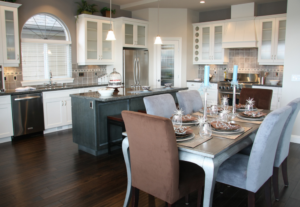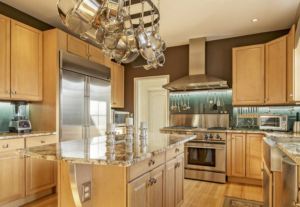
Staining wood is usually pretty cut and dried, and you would think that any type of wood could take a stain whether light or dark in color, but problems can arise when you are thinking of staining your wood cabinets in a darker stain, like espresso. You will want to make a specific wood cabinet choice and stain that will provide a good outcome.
Wood Processing Overview from Tree to Wood
With wood being an inconsistent type of material, its contents were once obviously part of a tree that lived in line with how much water it took in as well as the number of nutrients it was able to absorb, along with its exposure to different kinds of environmental conditions, plant diseases and damaging insects. That tree had to fight those forces that came against it in order to survive.
During its growing and survival process, the grains within the tree were developing and changing on a seasonal and yearly basis. The tree was also subject to malformations and bending through wind and other situations that probably modified it during its final growing and living stages, which determined its final outcome and eventual removal for use as a wood product.
Once a tree has been harvested and submitted to the various processes of milling, curing and drying, the wood species itself will exhibit different features and characteristics that will determine the effects of any type of stain used on it, particularly for a cabinet or other type of furniture piece. So, exactly what are the precise factors that determine how different types of wood will accept a stain?
Reaction of Wood Species to Different Stains
Moisture/Humidity
Even though wood goes through a drying process and its inner moisture or humidity levels are at an acceptable level (six to eight percent), that level can fluctuate in relation to storage and moisture levels in different areas and regions. A wood with less moisture is going to absorb stain more quickly, while one that is less dry will absorb less stain and be lighter in color.
Wood Absorbency or Porosity
Since wood has pores, and the larger those pores are in relation to a particular type of wood, the more the piece of wood will take a darker stain and absorb it; whereas, a wood type with smaller and more constricted pores will take less stain.
Color
Actual wood color of a specific species will also make a difference in acceptance of a stain. Woods that are light in color will absorb a stain more quickly as well as take it in faster. In contrast, a darker wood will take in less of a stain.
Types of Wood for Dark Stains
There are three types of wood that are more accepting of darker stains. They include:
Cherry – Though cherry wood is dark to begin with, it does contain a grain that is less noticeable, which makes it a good candidate for a stain like espresso. A dark stain will somewhat dull the original shiny appearance of cherry, but it will give a deeper color and texture that is conducive to more modern kitchen cabinet designs.
Hard Maple – This type of maple is the top choice for boosting the appearance of an espresso stain. Hard maple has the perfect color and textural aspects that can absorb an espresso stain at the right level, which results in a rich and deep brown appearance. Since the maple is a lighter wood, it is more conducive to accommodating a darker stain like espresso.
Red Oak – This wood species is comparable to cherry in its more glowing finish, and it is also affected by a darker stain. Red oak does exhibit a noticeable grain that provides a consistency that is enhanced with a darker stain such as espresso. There is, of course, a red coloration with this type of oak which will bring about more of a brown espresso along with red tinges.
If you are interested in using a darker stain like espresso on your kitchen cabinets but are still unsure what type of wood you want to use with it, complete the online contact form and an expert in darker stains will get back to you with the best choices available to you. You can find the right stain to enrich your cabinets and the appearance of your kitchen.






